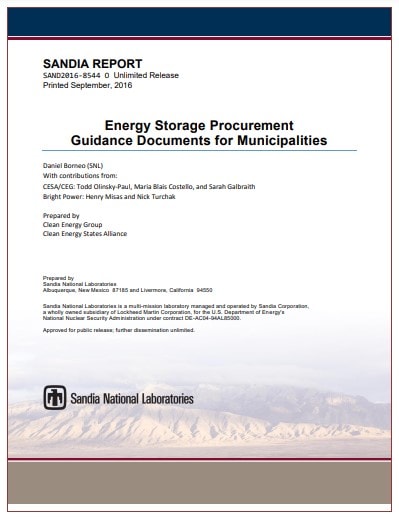July 13, 2016
US DOE, Sandia, CEG/CESA collaborate to provide municipal energy storage procurement guidance
By Todd Olinsky-Paul
Through a no-cost contract with Massachusetts Department of Energy Resources (DOER), CEG/CESA, in collaboration with US DOE-OE, Sandia National Laboratories (SNL), and Pacific Northwest National Laboratories (PNNL), has been providing hands-on technical assistance to Massachusetts resilient power projects that have received DOER grants. The assistance is intended to help these community projects with system design, procurement, installation, commissioning, testing and data collection – basically, to help ensure these projects are successful, both for the communities hosting them and for the state, as well as for the benefit of similar, future projects.
In speaking with community leaders about these resilient power projects, we noted a common theme; a number of communities needed help in the area of energy storage procurement. To address this need, CESA worked with DOE-OE, SNL and others to produce a set of Energy Storage Procurement Guidance Documents for Municipalities. This package, which is freely available on our website, contains two example RFPs for energy storage systems, one for a utility-scale system, and one for a smaller, behind-the-meter system. It also contains a matrix of elements that go into constructing an energy storage RFP. The matrix serves as a checklist of items that should be included in an energy storage RFP. It also suggests information that should be provided in the RFP and questions that should be asked of potential vendors. Finally, the matrix details what to look for in vendor responses.

Response to this resource has been very positive, with a number of municipalities indicating that it has helped them. Already, the document has been downloaded more than 200 times. And IEEE, the Institute of Electrical and Electronics Engineers, has invited our team to speak about the document at the IEEE Power & Energy Society General Meeting this month in Boston.
Clearly, there is a deep need for basic how-to information about developing energy storage and resilient power systems. Although many municipalities have gained some limited experience in the area of distributed energy resources, mostly due to the success of the distributed solar industry, adding energy storage and islanding capability to the mix raises a whole new set of questions. As we learn more about what communities need know in order to develop successful resilient power projects, we will continue to produce resources intended to bridge the knowledge gap, reduce risk, and ensure that systems will perform as advertised to benefit their host communities.














